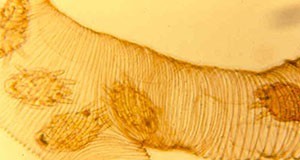Abstract
Tracheal mites are parasites of the western honey bee and negatively impact the health and productivity of an infested colony. This 6-page fact sheet details the method of dissecting honey bees in order to diagnose tracheal mites. Written by John Bonkowski, Ashley N. Mortensen, and James D Ellis, and published by the UF Department of Entomology and Nematology, January 2015.
References
Calderone, N., and H. Shimanuki. 1993. Distribution of the tracheal mite, Acarapis woodi, among the mesothoracic tracheal trunks of the honey bee, Apis mellifera. Experimental and Applied Acarology 17: 663-672. DOI: http://dx.doi.org/10.1007/BF00058506 https://doi.org/10.1007/BF00058506
Denmark, H., H. Cromroy, and M. Sanford. 2013. Acarapis woodi (Rennie) (Arachnida: Acari: Tarsonemidae). University of Florida, IFAS, Entomology and Nematology Department, Featured Creatures, EENY-172. (26 November 2014). http://entnemdept.ufl.edu/creatures/misc/bees/tracheal_mite.htm
Ellis, J. D. 2012. Tracheal Mites. University of Florida, IFAS, Entomology and Nematology Department, Honey Bee Research and Extension Laboratory, (26 November 2014). http://entnemdept.ifas.ufl.edu/honeybee/extension/TrachaelMites.shtml
Mortensen, A. N., D. R. Schmehl, and J. D. Ellis. 2013. Apis mellifera Linnaeus, and subspecies (Insecta: Hymenoptera: Apidae). University of Florida, IFAS, Entomology and Nematology Department, Featured Creatures, EENY 568. (26 November 2014). http://entnemdept.ufl.edu/creatures/MISC/BEES/euro_honey_bee.htm
World Organization for Animal Health. 2008. Acarapisosis of Honey Bees. Manual of Diagnostic Tests and Vaccines for Terrestrial Animals. pp. 388-394. Accessed online on (4 Oct. 2014). http://www.oie.int/international-standard-setting/terrestrial-manual/access-online
Sammataro, D., S. Cobey, B. Smith, and G. Needham. 1994. Controlling Tracheal Mites (Acari: Tarsonemidae) in Honey Bees (Hymenoptera: Apidae) with Vegetable Oil. Journal of Economic Entomology 87(4): 910-916. https://doi.org/10.1093/jee/87.4.910
Sammataro, D. 2006. An Easy Dissection Technique For Finding the Tracheal Mite, Acarapis woodi (Rennie) (Acari: Tarsonemidae), in Honey Bees, with Video Link. International Journal of Acarology 34(4): 1-5. DIO: http://dx.doi.org/10.1080/01647950608684479 https://doi.org/10.1080/01647950608684479
Sammataro, D., L. de Guzman, S. George, R. Ochoa, and G. Otis. 2013. Standard methods for tracheal mite research. Journal of Apicultural Research 52(4). DOI http://dx.doi.org/10.3896/IBRA.1.52.4.20 https://doi.org/10.3896/IBRA.1.52.4.20
Shimanuki, H., and D. Knox. 2000. Diagnosis of Honey Bee Diseases. U.S. Department of Agriculture. Agriculture Handbook No. AH-690. 61pp. http://www.ars.usda.gov/is/np/honeybeediseases/honeybeediseasesintro.htm

